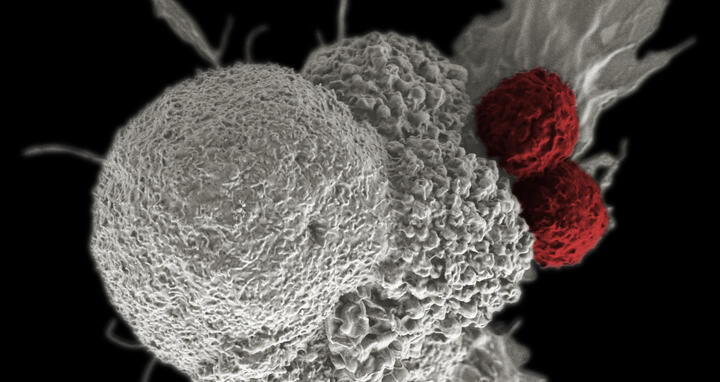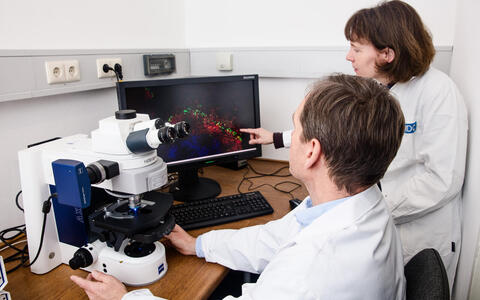Immunotherapy may get a boost
T cells are the immune system’s SWAT team. Their job is to constantly patrol the blood, lymphatic system, tissues, and organs. If they come across cells that are contaminated with or damaged by pathogens, they eliminate them. They can also recognize and destroy cancer cells. The problem, though, is that the tumor cells find ways of escaping this line of defense. Researchers around the world are working to prevent these evasive maneuvers and harness T cells for targeted immunotherapies against cancer.
The labs led by Dr. Armin Rehm and Dr. Uta Höpken at the Max Delbrück Center for Molecular Medicine in the Helmholtz Association (MDC) in Berlin have now identified a mechanism that tumor cells use to dodge the body’s immune response. “In many cases, tumor cells read the EBAG9 gene especially often. The cells then produce a protein that protects them. But EBAG9 also influences the cells of the immune system because T cells produce it too. In T cells, EBAG9 inhibits the secretion of enzymes that act as poison to kill tumor cells,” says Rehm. Writing in the journal JCI Insight, the researchers describe how they released this brake in mice: “We shut down the EBAG9 gene,” says co-lead author Dr. Anthea Wirges, who works in Rehm’s research group. “This meant we could stop EBAG9 being produced in the T cells and strengthen the immune response to cancer for the long term.”
EBAG9 disarms immune cells
We observed these modified mice over a long period of time. Their tumors developed much more slowly than in the mice with EBAG9.
Scientists already know that cancer cells can outwit immune cells. This knowledge led to the development of checkpoint inhibitors, a type of immunotherapy that is already in clinical use. Checkpoint inhibitors make it hard for the cancer cells to trick T cells into thinking they’re harmless. “But EBAG9 gives cancer cells another line of defense against our immune system,“ says Rehm. “It disarms the immune cells and stops them from secreting substances that would harm the cancer cells.”
Rehm and Höpken have long suspected that EBAG9 inhibits T cells. In 2009, Rehm’s ream developed a mouse model in which the researchers switched off the EBAG9 gene. “The mice’s immune system worked better without EBAG9 and they were able fight infections much more effectively,” says Rehm. Höpken’s team then crossed the EBAG9-free mice with another genetically modified mouse model that spontaneously developed leukemia. “We observed these doubly modified mice over a long period of time,” says Höpken. “Their tumors developed much more slowly than in the mice with EBAG9.”
Cancer and infections trigger different immune responses
Wirges checked the effects of the EBAG9 gene on the T cells using single-cell RNA sequencing and bioinformatic methods. As well as confirming that EBAG9 inhibits the T cell response, the data also showed that the immune response to cancer differs from the one triggered by infections.
Armin Rehm (left) and Uta Höpken (right)
“Knowledge about how the immune system develops a ‘memory’ comes from infection models. It can’t be transferred 1:1 to tumors,” says Rehm. T cells recognize diseased or infected cells by the signaling molecules on their surface. When they detect these harmful structures, they differentiate into cytotoxic T cells and memory T cells. The cytotoxic T cells secrete proteins that punch holes in the target cell’s membrane so that they can penetrate it and kill it by poisoning. Infected tissue also produces inflammatory signaling molecules, such as cytokines, that summon more T cells and cause them to mature into memory T cells. The memory cells record the immune response so that the immune system doesn’t have to start from scratch every time the T cells detect a disease.
The idea: Create CAR T cells without an immune brake
The stronger the initial T cell reaction, the better the subsequent T cell memory.
Tumors don’t cause inflammation in their early stages. Previously, scientists assumed that this was because T cells can’t identify tumor cells very well. “Because they’re produced by the body, tumor cells have very few surface molecules that are identifiable as foreign,” says Höpken. But it seems as if these minimal differences are enough for the T cells to spot the tumor cells: When the researchers switched off EBAG9, the reaction was astonishing. “The uninhibited T cells eliminate tumor cells very early and very radically,” notes Rehm. This also creates lasting protection against tumor cells. “The stronger the initial T cell reaction, the better the subsequent T cell memory,” says Rehm.
“Based on these findings, we now want to develop CAR T cells without EBAG9 as an immunotherapy for leukemia,“ says Wirges. CAR stands for chimeric antigen receptor – an artificial receptor that detects tumor cells and is integrated into the patient’s own T cells. When patients have a CAR T-cell infusion, it equips their body with cells capable of fighting the cancer. The MDC researchers expect the CAR T cells to be even more effective without EBAG9. Although it will be a while before the cells reach the clinical trial stage, it could well be worth the wait: “We aren’t just hoping that this therapy will result in more efficient treatments for leukemia and lymphoma. We’re hoping that it will cure them,” says Rehm.
Text: Jana Ehrhardt-Joswig
Further information
Literature
Armin Rehm et al. (2022): “EBAG9 controls CD8 + T cell memory formation responding to tumor challenge in mice.” JCI Insight, DOI: 10.1172/jci.insight.155534
Contacts
Dr. Armin Rehm
Translational Tumorimmunology Lab
Max Delbrück Center for Molecular Medicine in the Helmholtz Association (MDC)
+49-(0)30-9406-3817
arehm@mdc-berlin.de
Jana Schlütter
Editor, Communications Department
Max Delbrück Center for Molecular Medicine in the Helmholtz Association (MDC)
+49-(0)30-9406-2121
jana.schluetter@mdc-berlin.de or presse@mdc-berlin.de
- Max Delbrück Center for Molecular Medicine in the Helmholtz Association (MDC)
-
The Max Delbrück Center for Molecular Medicine in the Helmholtz Association (MDC) is one of the world’s leading biomedical research institutions. Max Delbrück, a Berlin native, was a Nobel laureate and one of the founders of molecular biology. At the MDC’s locations in Berlin-Buch and Mitte, researchers from some 60 countries analyze the human system – investigating the biological foundations of life from its most elementary building blocks to systems-wide mechanisms. By understanding what regulates or disrupts the dynamic equilibrium in a cell, an organ, or the entire body, we can prevent diseases, diagnose them earlier, and stop their progression with tailored therapies. Patients should benefit as soon as possible from basic research discoveries. The MDC therefore supports spin-off creation and participates in collaborative networks. It works in close partnership with Charité – Universitätsmedizin Berlin in the jointly run Experimental and Clinical Research Center (ECRC), the Berlin Institute of Health (BIH) at Charité, and the German Center for Cardiovascular Research (DZHK). Founded in 1992, the MDC today employs 1,600 people and is funded 90 percent by the German federal government and 10 percent by the State of Berlin.







